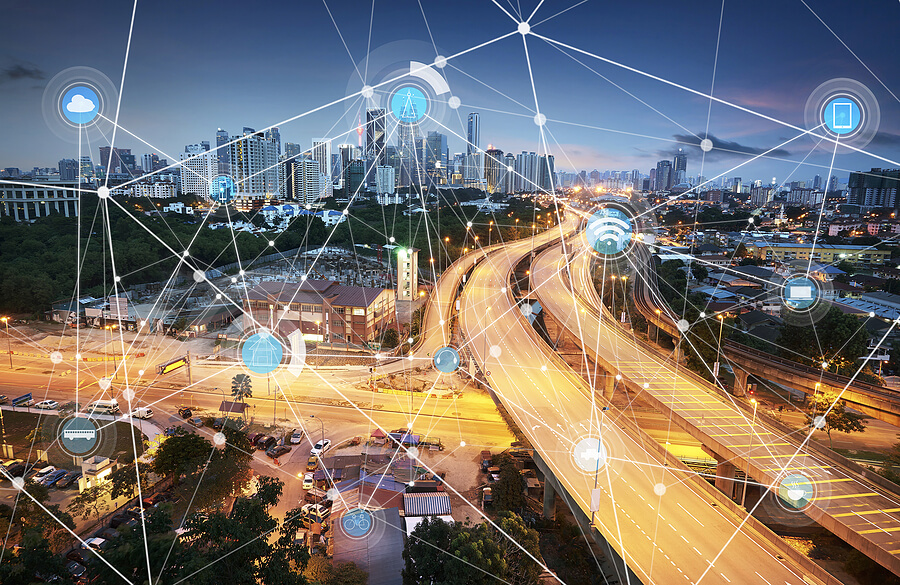5 Main IoT Challenges and its Potential Solutions
The first challenge the IoT industry is facing is of security and privacy. IoT devices have brought in security risks that are dangerous to both users and industries.

The IoT has grown to be a disruptive technology that connects physical things globally and facilitates comprehensive levels of communication and control. The application of IoT is vast and diverse, ranging from optimizing operations in industries to improving the way people live through smart devices. Though, along with these broad opportunities, IoT also offers rather significant threats and challenges that need to be addressed and solved.
As the IoT continues to spread across industries, it brings about factors that might make it challenging in terms of data security, device interoperability, and the need for scalable infrastructure. Solving these issues is crucial for any organization that wants to harness the possibilities that IoT offers but, at the same time, prevent possible dangers. Now, we will go through five critical challenges that are important to the IoT industry at the moment. Thus, it becomes necessary to address these challenges and seek their potential solutions.
#1 Security and Privacy Issues
This comes with a problem, as IoT devices have brought in security risks that are dangerous to both users and industries. Programs such as hacking attacks, malicious software, and data theft that threaten to leak crucial information and bring organization operations to a standstill are some of the common security threats. For example, the Mirai botnet in 2016 exploited the weakness of IoT devices, as the attackers were able to conduct extensive distributed denial-of-service (DDoS) attacks that affected major websites globally. Such incidents reveal that the some IoT systems are facing security flaw, and new security measures must be implemented in the systems.
Privacy is another emerging issue in the IoT, or the act of guarding data from being accessed by others without permission. Furthermore, IoT devices regularly capture and store information without break, and this information is frequently specific and delicate. This has implications for IoT data security because it increases the possibility that the wrong people will access and use the information improperly. For example, homes have smart devices that can gather a wealth of data about certain individuals, data that can be used in various ways to invade on their privacy.
Solution:
- Implementing robust encryption methods - Data encryption also works for both the data that is stored and the data that is being transferred, so even if intercepted, it cannot be read.
- Regular security audits and updates - This is very important because organizations that carry out frequent security audits are able to discover those gaps within the system. New threats continue to emerge, making it even more important to install software updates and apply security patches as often as possible.
- Educating users on security best practices - Instructing users about the appropriate security measures, like choosing a complex password, enabling two-factor authentication, and identifying phishing attempts, are some of the key ways of reducing security threats.
#2 Scalability and Integration
However, IoT is being used worldwide by organizations and businesses, but scaling up IoT systems is also a challenging task. The number of connected devices is rising due to increasing IoT use cases in various industries. As a result, networks risk becoming congested, and latency times are elevated.These devices generate a large amount of data, and therefore, there is a need to establish sufficient structures to handle and share information. These problems are often made worse by network bandwidth constraints and possible failure points that can slow down and diminish the results achieved.
However, integrating IoT with current systems creates an extra level of difficulty. Most enterprises still use outdated networks and other support infrastructures that cannot accommodate today’s IoT devices. This causes problems in providing transitions between old and new technologies in terms of communication and information sharing. However, there is an incompatibility due to the presence of numerous IoT platforms and devices, each with its own protocols and standards. But this lack of uniformity can hinder the coordinated functioning of a broad IoT system.
Solution:
- Using scalable IoT platforms and cloud services - The adoption of cloud-based solutions and the use of IoT platforms that are future-proof allow for the expansion of capacity for the number of devices and the load on data. These types of resources are flexible, meaning they can be added or decreased depending on the need while at the same time delivering the same level of performance and dependability.
- Standardization efforts and APIs for better integration - There is agreement on the relative operational procedures, and the creation of APIs enhances proper compatibility between different IoT devices and networks. In cases where it is possible to reach consensus, common initiatives can prevent complexity and make the IoT landscape more coherent across industries.
#3 Data Management and Analysis
With the exponential rise in IoT devices, there is a huge amount of data produced, and managing data is a major issue. IoT systems generate raw data from a multitude of sensors and connected devices on a perpetual basis, which necessitates a strong foundation for data management and processing. Some traditional methods of storing data in a centralized location may have difficulties accommodating this increase and, hence, slow down.
Data analysis is an important step in achieving business value from IoT data, as it helps translate raw data from IoT devices into actionable insights. But this process requires advanced instruments and methods to make the data credible and appropriate for obtaining insights. If the data collected is inaccurate or irrelevant, the insights drawn from it would be equally erroneous, and this would have a negative impact on the decision making process as well as the overall functioning of an organization. Furthermore, IoT has a broad range of data, and it is not put into a particular structure to be analyzed; therefore, it requires sophisticated techniques to extract useful information from it.
Solution:
- Implementing edge computing - Edge computing is a technique where the data is analyzed near the source of the data, or at the edge of the network. It is used to minimize data overload by filtering and analyzing the data locally and passing only the useful information to the centralized systems. It reduces latency and bandwidth utilization, thus improving the general system performance.
- Leveraging AI and machine learning - Advanced analytics also employs artificial intelligence (AI) and machine learning (ML) algorithms. These technologies can also learn patterns and trends, recognize outliers, and make forecasts on large sets of data. With the use of AI and ML, organizations can be able to understand better and enhance decision making.
- Utilizing data lakes and advanced storage solutions: Data lakes provide a more adaptable storage structure in which a broad range of data can be stored. Data lakes can hold both structured and unstructured data as opposed to a conventional database, making it easier to manage IoT data at scale. Alongside the sophisticated storage technologies, data lakes facilitate the storage, search, and analysis of IoT data.
#4 Power Supply and Energy Consumption
One of the challenges of incorporating IoT devices is the high energy requirements of these devices, especially when they are constantly active. Most IoT applications demand devices to be on all the time, which is rather power consuming. This is specifically true for remote monitoring and portable IoT devices, which suffer from battery problems that may affect the operation and durability of the devices.
Charging and maintenance of these devices are often required to keep them in good working condition most of the time. It not only raises the maintenance cost but also brings about possible time loss and organizational problems. Products that need charging or battery replacement frequently hinder operations and end up being more expensive in the long run.
Solution:
- Development of low-power IoT technologies - The proliferation of low power electronics and power efficient communication interfaces can bring down the power consumption of IoT devices to a large extent. These technologies are meant to complete necessary remote tasks while employing as little energy as possible, prolonging the working existence of the devices.
- Adoption of energy harvesting methods - Power supply methods like solar, kinetic, or thermal energy conversion offer green power solutions for IoT applications. These methods allow energy to be harvested from the surrounding environment, thereby lessening dependence on conventional batteries and charging less often.
- Optimizing device sleep modes and power management - Additional measures that involve intelligent power management techniques, like the optimization of device sleep modes, can be taken to reduce energy consumption. It is possible to set the device to operate in low power states when not actively engaging with them to save power and battery.
#5 Regulatory and Compliance Challenges
The difficulties in managing the regulations of the IoT stem from the current situation, where there are a vast number of regulations and standards that are highly diverse and complex. Every geographic location and area of operation has its own unique set of legal rules and regulations to follow, which makes compliance a challenge. For example, the EU’s General Data Protection Regulation established strict data protection measures, as the California Consumer Privacy Act does in the United States. These regulations require sound measures to safeguard consumer data and their privacy.
This is on top of general data protection laws and industry specific laws, which make the laws even more complicated. For instance, the healthcare industry needs to adhere to the Health Insurance Portability and Accountability Act (HIPAA) in the United States, which implies strict measures concerning patients’ information. Likewise, there are rules like the Payment Card Industry Data Security Standard (PCI DSS) that apply to the finance industry and deal with securing payment card information.
Solution:
- Proactive monitoring of regulatory updates - Another one is maintaining awareness of the regulatory environment. Companies need to keep abreast of such changes in laws and standards with a view to maintaining constant compliance.
- Engaging with regulatory bodies and industry groups - Getting involved in trade associations and interacting with the regulatory authorities can be useful in identifying future trends in regulations and recommended practices. This involvement helps businesses be prepared for any change that is likely to occur in the market.
- Implementing compliance management systems - It is important to note that compliance management systems can help organizations implement compliance more easily. These systems are designed to automate compliance checks, maintain required documentation, and ensure that all aspects of IoT operations are legal and compliant with the appropriate laws and regulations.
Conclusion
Thus, the five main issues of the IoT industry can be highlighted as the security and privacy question, the question of scalability and integration, the question of data management and analysis, the question of power supply and energy consumption, and the question of regulation and compliance. It is therefore imperative to address some of these challenges in order to fully harness the potential of IoT technology. It is important for all industry participants to work together and create comprehensive solutions that allow for safe, fast, and compliant IoT applications. In order to provide solutions for these challenges and ensure the success of IoT, it is crucial to remain informed and to act preemptively. Altogether, it is possible to construct a better and wiser world that is more linked and less vulnerable.
